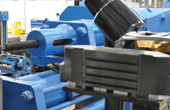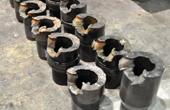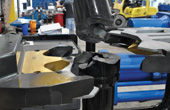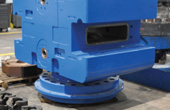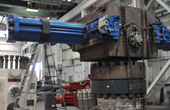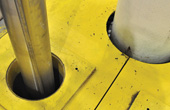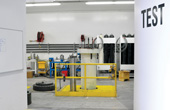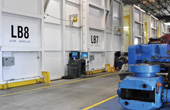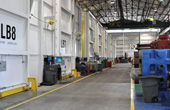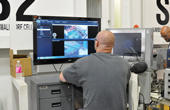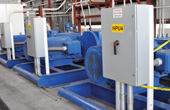BOP testing facility focuses on robustness, reliability of components
R&D center applies manufacturing principles to maximize testing capacity, efficiency
By Joanne Liou, editorial coordinator
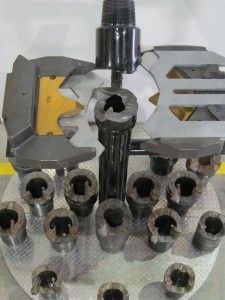
As the industry continues to place new rigs into the market, the rippling effects on demand for BOPs and improved BOP technologies parallel the upward trend. National Oilwell Varco (NOV) is responding with increased capacity, not only in manufacturing but also in testing. The company recently opened a new US $15 million BOP R&D facility in Houston. “The amount of expansion we’ve had an as organization, the number of BOPs we’ve been selling – we knew we had to increase capacity,” Frank Springett, vice president of the NOV pressure control group, said. “We were doing between three and 10 tests in a month (at the old R&D facility). We’ve run up to 31 tests in a week at the new facility. Applying manufacturing principles to an R&D test environment, as odd as that sounds, has proven to be very successful.”
In operation since October 2011, the facility was built with manufacturing principles in mind. “When we designed the lab, we took all the tests we wanted to do and modeled them into a capacity-planning software. We determined how many and what kind of test bays we needed to be as effective and be able to execute as many tests as we could,” Mr Springett said. “It’s about capability and capacity, which is having not one but three cold rooms that get really cold, high-temperature areas that get to the high temperature and having the flow capacity to be able to do all kinds of tests.”
At the previous facility, NOV realized, its testers were spending too much time and effort prepping for tests and procuring parts. “By planning ahead and setting up specific cells where there’s people dedicated to get the BOPs and get the product ready for the next test, then the testers do just that – test,” Mr Springett explained.
“The engineers launch a work order to us with the test procedures,” Billy Bruce, R&D lab manager for the NOV pressure control group, said. “We run that test, and we bend it, break it – we do everything we can to make it fail, and then we pass all that data to engineers such that they can consider that in the final design.”
Taking lessons from the manufacturing side, the lab’s operations are featured on a dashboard that can be accessed on the NOV network, so the entire facility can track the details of work orders, status of tests and metrics. The organization and infrastructure of the work order system help engineers focus on engineering, not chasing parts. “We have a procurement group that deals with buying the rubber goods and making sure they’re there on time so our engineers are not doing that,” Mr Springett said.
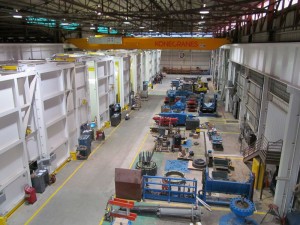
The facility houses 13 test bays, eight large and five smaller ones dedicated to land BOPs. The distribution of the test bays was intentional because “subsea always seems to take priority just in the nature of its size, its cost. By having a dedicated small bore area, we can maintain focus on small bores, which means we maintain the urgency on things that are still very important,” Mr Springett explained.
The test bays are ballistic certified, with sand-filled walls 30 in. thick with steel reinforced to the impact zones. There are three cold rooms that can drop to as low as -25°F and heaters that can bring BOPs up to 400°F. The facility also is equipped with a hyperbaric chamber, which can simulate water depths up to 15,000 ft. The chamber is used to test depth compensator accumulators and the effects of water depth on control systems. High-definition cameras placed above the testing bays keep people out of harm’s way.
“Our main job here is testing rubber goods, which is ram block seals and elements,” Mr Bruce said. “We also measure the longevity of the equipment itself, and we’re getting to the point where we’re trying to figure out how many cycles this certain piece of equipment can handle before you have to replace internal components.”
Besides testing, NOV continues work on a myriad projects to improve BOP robustness and reliability, including a 20,000-psi BOP system, a non-locking floating choke and kill stab, low force shear rams with an integrated centralizer, a visual ram position indicator, depth compensated accumulators, high-temperature multirams and a 10,000-psi annular with a 15,000-psi pressure rating on the BOP housing.
20,000-psi system
The eight large test bays at the facility were designed in anticipation of shell testing of a 20,000-psi BOP at 1.5 times operating pressure. The facility’s wellbore system is capable of reaching 30,000 psi. The engineering behind the project is in the BOP elastomer and its system of three components: the ram block, the rubber compounds used in the elastomer, and the metal segments and how they are designed, Mr Springett explained. “We think we’ve found the correct combination of those three things to get us to high-temperature, 20,000-psi multi-rams.”
Working on a 250°F multi-ram, NOV tested it for eight hours and successfully increased the temperature to just under 300°F for 18 hours. “We opened the ram blocks, and they looked brand new,” Mr Springett said. “It’s the combination of those components that will enable us to get there. If you can successfully execute on multi-rams from the 20,000-psi BOP range, then you’ll be able to reduce the total number of cavities, which makes the stacks much lighter and smaller.”
Choke and kill stab
Choke and kill stabs require tight tolerances that can be difficult and complex to install and maintain. NOV is easing the task with a choke and kill stab that is fixed, non-locking and provides a half-inch diametrical clearance, which will enable interchanging LMRPs from one stack to another.
“If you have one stack that is configured with very fine alignment requirements and you bring another stack or LMRP that is not precisely the same within 10 to 15 thousandth of an inch, it makes making those stacks or LMRPs interchangeable very difficult,” Mr Springett said. NOV expanded what was once a paper-thin working range to a quarter of an inch radial or a half-inch diametrical clearance. The stab is simply designed, with one moving part and one additional seal, borrowing technologies used in ram blocks. “We work on applying the technology that works well in one area of our business to other areas of our business,” Mr Springett stated.
The interchangeable element puts the repair and maintenance off the critical path, increasing flexibility. If a problem arises with the LMRP, it can be disconnected from the sea floor on the lower stack and replaced with a spare LMRP that will land properly, he explained. “It means you have the time on surface to figure out what the issues are on that specific LMRP; you’re taking it off the critical path to do the work that you have to do, whether it be repair or maintenance.”
Ram position indicator
A small device that sits at the tail-end of the BOP operator visually indicates the physical location of a ram. NOV’s ram position indicator (RPI), which increases the length of the operator by 3 3/4 in., uses a dial to show the degree of the ram position, which can be checked via an ROV. “Currently, in order to know the position of the ram, crews have to check the flow that went into the rams. You have to know what the flow was. The RPI gives us another method to verify positively the location of each BOP ram operator,” Mr Springett said.
Integrated centralizer and low-force shear rams
NOV has completed more than 600 shear tests to understand the mechanics of the shear and the machining technology that impact the efficiency of shear blades. Results indicated that the efficiency of the low-force shear is designed in the geometry of the blade and where the tubular is relative to that geometry. “In some cases, conventional rams use five to six times more force to shear than the new low-force shear rams,” Mr Springett stated.
To ensure that the tubular is in the right spot for taking advantage of that efficiency, NOV has developed its centralizer with plates that sit at the bottom of the ram, which push the pipe to the center. Once the pipe reaches the center and the tubular has been punctured, then a trigger located in the middle will release and the plates move out of the way for the shears, Mr Springett explained.
10,000-psi annular to handle 15,000 psi
With the capping stacks that industry has recently developed, one challenge has arisen with the BOPs being built with both annulars and LMRP. Customers are driving the demand to increase the annular body to handle 15,000 psi.
“You can put a 15,000-psi annular on the lower stack and put a 15,000-psi capping stack on top,” Mr Springett explained. “We’re working on a 10,000-psi annular that has a housing rating for 15,000 psi so you can put the annular back into the lower stack if need be.” Essentially, it is the same 10,000-psi BOP component but with enough structural rigidity to handle 15,000 psi around the whole BOP.
Improving robustness and reliability in a system as complex as a BOP is a challenge that involves “shifting the culture from what was to what is,” Mr Springett said. While there are numerous projects under way to address multiple aspects of the BOP, they all share the goal to provide a robust and reliable solution as a whole, and test after test are necessary to reach that goal. “We have to fully qualify it. We’re not going to send technology out that is not fully qualified,” Mr Springett said. “Timelines are very important, but making sure the product is right is even more important.”
Image Gallery
Click any image to zoom

